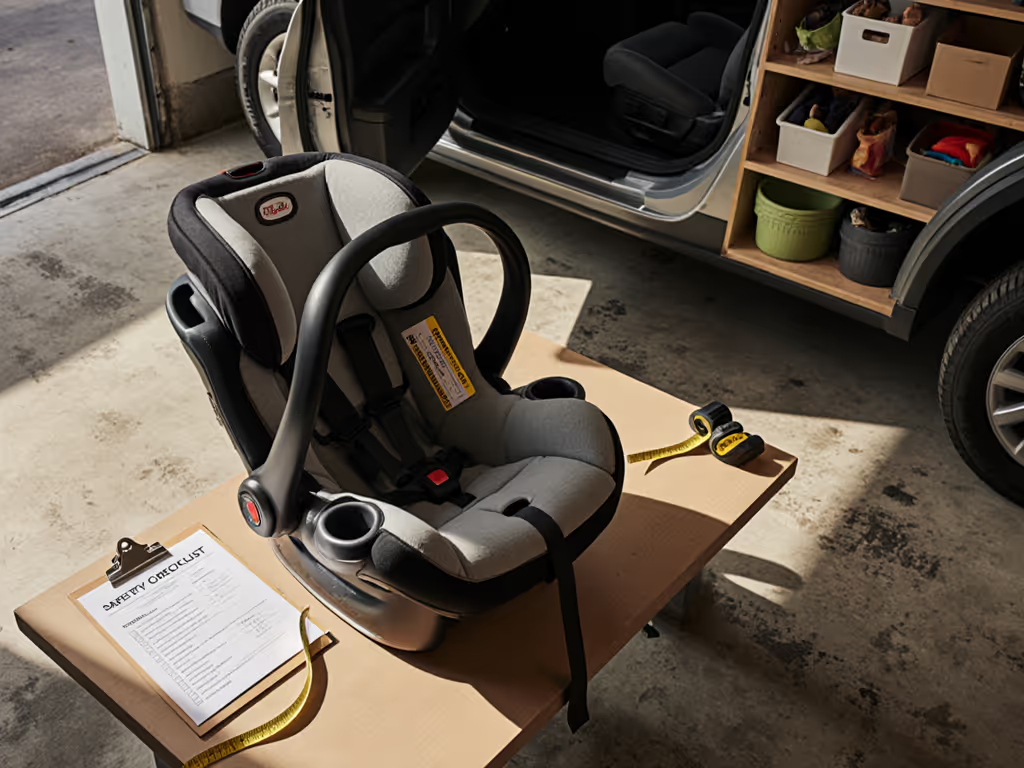
Car Seat Expiration Dates: Everything You Need to Know

Surprisingly, nearly 1 in 3 parents admit they have never checked their child's car seat expiration date. This small detail can have a huge impact on safety, as outdated seats may quietly lose their ability to protect during a crash. Understanding how car seats age, why they become less effective, and what steps to take can help keep every ride safer for the youngest passengers.
Key Takeaways
| Point | Details |
|---|---|
| Expiration Essentiality | Car seats typically expire between 6 to 10 years due to material degradation and evolving safety standards. |
| Material Risk | Environmental stressors can cause invisible deterioration, compromising safety features. |
| Mandatory Replacement | Using expired car seats increases the risk of injury due to compromised structural integrity and outdated safety technologies. |
| Responsible Disposal | Proper disposal of expired car seats is crucial to prevent reuse; consider recycling options and community programs. |
Understanding Car Seat Expiration Dates
When it comes to child safety, not all parents realize that car seats have an actual expiration date. These aren't just suggestions buried in fine print - they're critical safety guidelines backed by rigorous research from organizations like the National Highway Traffic Safety Administration (NHTSA).
Car seat expiration dates typically range between 6 to 10 years from the date of manufacture. This might seem surprising, but these timeframes aren't arbitrary. Material degradation plays a significant role in why car seats cannot be used indefinitely. Plastic components break down over time, experiencing stress from temperature fluctuations, UV exposure, and repeated use. Imagine leaving a plastic toy in direct sunlight for years - it becomes brittle, discolored, and weak. Car seats undergo similar structural changes that compromise their protective capabilities.
Safety standards evolution represents another crucial reason for expiration dates. As engineering and child passenger protection technologies advance, older car seats may no longer meet the latest safety recommendations. The American Academy of Pediatrics strongly emphasizes adhering to these expiration timelines to ensure maximum child protection.
Here's a summary of the main reasons for car seat expiration:
| Reason | Description |
|---|---|
| Material Degradation | Plastics weaken<br>Harnesses lose strength |
| Evolving Safety Standards | Older seats may not meet latest guidelines |
| Unseen Structural Damage | Wear can make seats unsafe |
| Advanced Technologies | Newer models offer better protection |
- Typical car seat lifespan: 6-10 years
- Key expiration factors:
- Material degradation
- Technological advancements
- Potential unseen structural damage
Locating your car seat's expiration date is straightforward. Check the manufacturer's label, typically found on the seat's side or bottom. This label will display the manufacture date, allowing you to calculate the seat's remaining usable period. When in doubt, consult the car seat's manual or contact the manufacturer directly.
How Car Seat Materials Degrade Over Time
Every car seat is a complex piece of safety equipment, vulnerable to material deterioration that can compromise its protective capabilities. Unlike other baby gear that might simply wear out cosmetically, car seat degradation represents a serious safety concern that can happen invisibly and gradually.
The primary culprits of material breakdown are environmental stressors. Ultraviolet radiation from sunlight breaks down plastic polymers, causing microscopic cracking and structural weakening. Temperature extremes accelerate this process - imagine a car seat enduring scorching summers and freezing winters. Repeated heating and cooling cycles cause materials to expand and contract, creating tiny stress fractures that aren't immediately visible. Plastic becomes brittle, fabric loses elasticity, and harness webbing can develop hidden structural weaknesses.

Chemical interactions also play a significant role in material degradation. Sweat, spills, cleaning products, and even sunscreen can interact with car seat materials, potentially compromising their molecular structure. The chemical breakdown might not be apparent to the naked eye but can substantially reduce a car seat's ability to protect a child during a collision.
- Key Material Degradation Factors:
- Direct sunlight exposure
- Temperature fluctuations
- Chemical interactions
- Mechanical stress from regular use
Professional child safety experts recommend periodic visual inspections. Look for signs like:
- Visible cracks in plastic components
- Fraying or stretched harness straps
- Faded or discolored materials
- Stiffness in previously flexible parts
Remember, material degradation is a silent process. Just because a car seat looks fine doesn't mean it remains structurally sound. Regular professional assessments and strict adherence to manufacturer expiration dates are your best defense against potential safety risks.
Roles of Safety Standards and Manufacturers
The world of child passenger safety isn't just about creating car seats - it's about creating lifelines that protect the most vulnerable passengers. Manufacturers and safety standards organizations work together in an intricate dance of engineering, research, and continuous improvement to ensure every car seat represents the gold standard of child protection.
Federal safety regulations serve as the foundational blueprint for car seat design. The National Highway Traffic Safety Administration (NHTSA) establishes minimum performance requirements that every car seat must meet. These standards are not static documents, but living guidelines that evolve with technological advancements and crash research. Manufacturers must not only comply with current standards but anticipate future safety improvements, constantly redesigning and testing their products to stay ahead of potential risks.
Manufacturers carry significant responsibilities beyond initial design. They must provide comprehensive documentation explaining proper installation, usage limitations, and critical maintenance guidelines. This includes clearly marking expiration dates, detailing material degradation risks, and offering precise instructions for replacement. The manufacturer's label becomes more than just a piece of information - it's a critical safety communication tool that guides parents in protecting their children.
- Key Manufacturer Responsibilities:
- Design seats meeting federal safety standards
- Conduct rigorous crash testing
- Provide clear usage instructions
- Mark definitive expiration dates
- Offer replacement guidance
"Every car seat is a potential life preserver, and manufacturers must treat its design with that level of commitment." - Child Passenger Safety Expert
Parents should view manufacturer guidelines not as suggestions, but as professional recommendations backed by extensive scientific research.
 Checking for recalls, understanding installation requirements, and respecting recommended replacement timelines are crucial steps in maintaining a car seat's protective capabilities.
Checking for recalls, understanding installation requirements, and respecting recommended replacement timelines are crucial steps in maintaining a car seat's protective capabilities.
Risks of Using Expired Car Seats
The decision to continue using an expired car seat might seem innocent, but it's essentially gambling with a child's life. Structural compromise isn't just a theoretical risk - it's a documented reality that can transform a protective device into a potential hazard during a critical moment of impact.
At the most fundamental level, expired car seats suffer from material fatigue that undermines their core protective mechanisms. Plastic components that were once rigid and strong become brittle and prone to cracking. Harness systems lose their original elasticity, potentially failing to restrain a child during a sudden collision. The National Highway Traffic Safety Administration warns that these degraded materials can dramatically reduce a car seat's ability to absorb and distribute crash forces, leaving children vulnerable to more severe injuries.
Technological obsolescence represents another significant risk. Safety standards evolve rapidly, and an expired car seat might lack critical design improvements that could prevent injury. Modern car seats incorporate advanced energy-absorption technologies, improved side-impact protection, and more sophisticated harness mechanisms. An older seat becomes not just less effective, but potentially dangerous when compared to current safety engineering standards.
- Critical Risks of Expired Car Seats:
- Compromised structural integrity
- Reduced energy absorption capabilities
- Potential harness system failure
- Outdated safety technologies
- Increased injury potential during crashes
"An expired car seat is like an outdated parachute - it might look fine, but when you need it most, it could catastrophically fail."
Insurance companies and legal experts increasingly recognize expired car seats as potential liability issues. Some jurisdictions might even consider using an expired car seat a form of negligence. The minimal cost of replacement pales in comparison to the potential medical and emotional consequences of a preventable injury.
Disposal and Replacement of Expired Car Seats
Replacing an expired car seat isn't just about buying a new product - it's about recommitting to a child's safety with deliberate, responsible action. The process requires careful consideration, from selecting the right replacement to ensuring the old seat cannot potentially harm another child.
Properly disposing of an expired car seat means more than simply tossing it in the trash. Safety experts recommend rendering the seat unusable before disposal to prevent potential reuse by unsuspecting individuals. This typically involves several strategic steps: cutting the harness straps, breaking the plastic shell, and removing the manufacturer's label. Some communities offer specialized car seat recycling programs, while others require more comprehensive disposal methods. Contact local waste management authorities or child safety organizations for specific guidance in your area.
When selecting a replacement, parents must consider multiple factors beyond just the expiration date. Compatibility with your vehicle, your child's current age and size, and current safety standards are critical considerations. Modern car seats often incorporate advanced safety technologies like improved side-impact protection, more sophisticated harness systems, and enhanced energy absorption mechanisms. Always verify that the new seat meets current federal safety standards and fits appropriately in your specific vehicle model.
- Disposal Checklist:
- Cut harness straps
- Destroy plastic shell
- Remove identification labels
- Check local recycling options
"A car seat's end of life is not just about age - it's about ensuring no other child could potentially be at risk."
Financial constraints shouldn't compromise safety. Many communities offer car seat exchange programs, trade-in events at retail stores, and assistance programs for families needing replacement seats. Some insurance providers and local health departments provide resources to help families maintain up-to-date car seats without significant financial burden.
Protect Your Child with the Right Car Seat Before It Expires
Understanding car seat expiration dates is crucial because material degradation and evolving safety standards make using expired seats risky. You want peace of mind that your child is protected by equipment built to the latest safety guidelines and free from unseen structural damage. If you are worried about choosing a seat that fits your vehicle, complies with the newest federal regulations, and lasts through your child's growth stages, you are not alone.
At Fits for Years Seats, we provide expert, research-driven advice designed to help you pick convertible car seats that maintain safety and comfort over time. Our guides cover everything from installation tips to detailed comparisons focused on longevity and compliance. Do not wait until your current car seat reaches its expiration date or shows signs of wear. Visit Fits for Years Seats now and take control of your child’s safety with confidence.
Frequently Asked Questions
What is the typical lifespan of a car seat?
Car seats usually have an expiration date ranging from 6 to 10 years from the date of manufacture. This timeline is based on material degradation and evolving safety standards.
How can I find the expiration date of my car seat?
You can locate the expiration date by checking the manufacturer's label, which is typically found on the side or bottom of the seat. This label will provide the manufacture date, allowing you to calculate the seat's remaining usable period.
What happens if I use an expired car seat?
Using an expired car seat poses several risks including compromised structural integrity, reduced energy absorption capabilities, and outdated safety technologies. These factors can significantly increase the risk of injury during a collision.
How should I dispose of an expired car seat?
To properly dispose of an expired car seat, you should cut the harness straps, destroy the plastic shell, and remove the manufacturer's label. Consider checking local waste management resources for specific disposal options or recycling programs.
![]()




